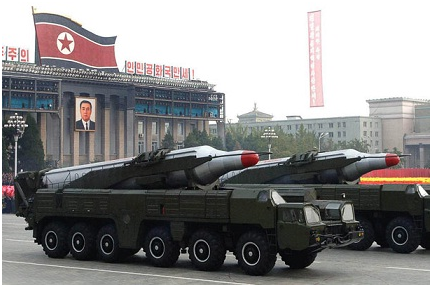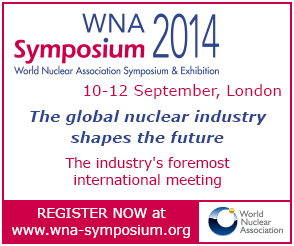
Blog
-
Geiger Readings for September 25, 2014
Ambient office = 84 nanosieverts per hourAmbient outside = 90 nanosieverts per hourSoil exposed to rain water = 100 nanosieverts per hourOrange bell pepper from Top Foods = 111 nanosieverts per hourTap water = 111 nanosieverts per hourFiltered water = 99 nanosieverts per hour -
Nulcear Weapons 94 – U.S. – Russia – China – Pakistan Are All Upgrading Their Nuclear Arsenals
My last post discussed the work being done in North Korea on the development of tactical nuclear weapons. While North Korea is a wild card in the international nuclear weapons arena, there are other more important players who are working on their arsenals.
President Obama has been a strong advocate for global nuclear disarmament since before he was elected. In 2009, he signed an agreement with the then president of Russia to cut strategic nuclear arms. Unfortunately, when the current Russian president seized the Crimea in Ukraine this year, the momentum toward nuclear disarmament slowed. The Russian President recently mentioned nuclear weapons in discussing possible conflict in Eastern Europe. In the past month, Russian fighters and Russian nuclear bombers entered the identification zone off the West Coast of the U.S. and Canadian.
Last month, the Kansas City National Security Campus was dedicated in Kansas by the U.S. government to assist in the revitalization the aging nuclear warheads in the U.S. arsenal. The plant is part of a nationwide program which includes creating a new generation of nuclear weapon delivery systems. The projected cost of these new programs is three trillion dollars over the next three decades. With new Russian and Chinese belligerence, it would be politically impossible for Obama to pursue significant cuts in U.S. nuclear weapons.
Russia had announced recently intentions to renew its strategic nuclear forces by seventy percent by 2020. Now Russia has just announced that the renewal will be one hundred percent by 2020. The Defense Minister of Russia also said that thirty percent of the army and navy weapons would be switch to “cutting edge” technologies in 2015. He hinted that there were some secret weapons projects going on as well.
Last month, China admitted the existence of the rumored Dongfeng-41A, a “next generation” intercontinental ballistic missile which can carry ten nuclear warheads and travel up to twelve thousand miles. International treaties have forged that banned the creation of such multiple-warhead missiles between Russia and the U.S. Unfortunately, Russia backed out of the treaty.
Pakistan recently announced that it would be creating a fleet of submarines to carry sea launched nuclear tipped missiles. This expansion of capability is obviously aimed at India which has a new right-wing government that has been ratcheting up belligerent rhetoric toward Pakistan since it was elected. The idea behind the new submarine fleet is to warn potential attackers (India) that even if Pakistan was decimated with an unexpected nuclear attack, the submarines would be able to launch a devastating retaliatory nuclear strike against the attacker. Unfortunately, if either Pakistan or India launched a nuclear strike on the other, within months, the prevailing winds would carry the nuclear fallout back over the attacker. It would be suicidal.
With Russia, the U.S. and China announcing major nuclear upgrades, it appears that we are entering a new nuclear arms race that might return us to the instability of the Cold War period. As dangerous as the possibility of intentional nuclear war may be, the possibility of an accidental nuclear war breaking out is even more worrisome.
Architect’s model of the new National Security Campus in Kansas City:
-
Geiger Readings for September 24, 2014
Ambient office = 85 nanosieverts per hourAmbient outside = 78 nanosieverts per hourSoil exposed to rain water = 84 nanosieverts per hourCelery from Top Foods = 123 nanosieverts per hourTap water = 80 nanosieverts per hourFiltered water = 71 nanosieverts per hour -
Nuclear Weapons 93 – North Korea Working on Tactical Nuclear Warheads and Delivery Systems
I have written previous posts about the nuclear aspirations and efforts of North Korea. They have tested intermediate range rockets and have been working hard on miniaturizing nuclear warheads so that they can be carried by their missiles. Even though they have a huge army, it is poorly equipped and would not be effecting in conventional warfare against a well armed foe such as South Korea. N.K. is developing nuclear weapons because they would give N.K. an edge in a conflict with South Korea.
The strategic nuclear missiles in the arsenals of nations with nuclear weapons are intended to carry big nuclear warheads on intercontinental flights. These warheads are designed to do major damage to large areas such as cities, factory complexes or military bases. N.K would not like to devastate huge areas of South Korea with strategic nuclear bombs because they want to invade and hold South Korea. There is also the probability that there would be major fallout in N.K. if they dropped big nuclear warheads on the South.
In the last decade, N.K. developed their “transporter erector launchers” or mobile artillery rocket launchers with the assistance of the Chinese. These launchers can fire three hundred millimeter diameter artillery rockets that can carry about two hundred pounds of explosives.
Since 2010, N.K has produced a new version of the three hundred millimeter mobile rocket launchers with the assistance of the Russians. The new launcher was made public in May of 2013. N.K. has also been working on the KN-10, a three hundred millimeter rocket based on the Russian SS-21 ground-to-ground missile. This rocket will be able to carry over a thousand pounds of explosives up to one hundred and twenty four miles. It was announced publicly in August of this year.
It is believed that N.K. is also working on miniature tactical nuclear warheads for the KN-10 missile. Tactical nuclear warheads are much smaller than strategic nuclear warheads and are intended for use on battlefields against military targets. Their use in a conflict with South Korea would give the North Koreans an advantage on the battlefield and would leave most of South Korea undamaged.
Even without tactical nuclear warheads, the new KN-10 missiles are much more powerful and would cause much more damage than the old generation of three hundred millimeter artillery missiles. The United States has troops on edge of the Demilitarized Zone between North and South Korea. They are there so that an attempt to invade South Korea by North Korea would encounter these U.S. troops and trigger war with the U.S. With tactical nuclear weapons in the mix, a war on the Korean peninsula would be more complex. South Korea does not have nuclear weapons and the U.S. would have to decide whether to answer North Korean aggression with U.S. tactical nuclear weapons.
Example of a North Korean missile and mobile launcher:
-
Radiation News Roundup September 23, 2014
An extremely radioactive used car was almost to be imported from Japan to Russia. fukushima-diary.com
Russia expects that within two years it will receive a contract to construct Jordan’s first nuclear power plant following the signing of a project development agreement. world-nuclear-news.org
Statements by a European Commission spokesman indicate the UK’s Hinkley Point C nuclear power plant project will be approved under state aid rules. world-nuclear-news.org
-
Geiger Readings for September 23, 2014
Ambient office = 107 nanosieverts per hourAmbient outside = 73 nanosieverts per hourSoil exposed to rain water = 70 nanosieverts per hourIceberg lettuce from Top Foods = 100 nanosieverts per hourTap water = 137 nanosieverts per hourFiltered water = 122 nanosieverts per hour -
Nuclear Reactors 167 – Nuclear Insurance – Part 2
This is Part 2 of my post about nuclear insurance issues. (see Part 1 posted on 9/19/14.) Part 1 discussed the current insurance situation and some of the related problems that were presented at the 2014 World Nuclear Association Symposium held in London. In this post, I am going to talk about some possible improvements in the global nuclear insurance industry.
The European Commission recently discussed the fact that current compensation limits are not realistic in view of the probable cost of a major nuclear accident. They also talked about a new system for nuclear accident compensation that would draw up to twenty billion dollars from a variety of sources to create a compensation pool.
The sources of money for the compensation pool would include the self insurance system currently in place in the United States. Additional funds would come from specialist insurance pools and mutual funds. And, finally, drawing funds from a whole new sector of the insurance market that is currently reluctant to get involved with nuclear accident compensation because of the problems with defining nuclear damage and prescription periods for payouts. One of the primary benefits of the proposed system would be to lower the burden the current system places on the taxpayer.
Drawing on this compensation pool of funds would be based on simple triggers that would release payments only in the case of a very serious nuclear accident. One possible trigger would be an event that rated above a level 5 on the International Nuclear and Radiological Event Scale. Another possible trigger would be the detection of certain levels of radiation around the site of an accident. The purpose of the triggers would be to remove current ambiguity about the type of events and situations that should result in compensation of victims.
The new system would not require that every operating nuclear reactor site have highest possible coverage. Individual insurance firms would be able to limit their exposure to only one or two triggering events. If fully implemented, the new insurance model should be obligatory to everyone in the nuclear industry. There has to be enough income from premiums in order to make it worthwhile for the insurance industry to make major financial commitments to the program.
This system of “risk transfer insurance” steps in with “distress funding” when a major unexpected event threatens the financial stability of a company. With this system in place, a nuclear power plant owner could focus on dealing with getting a nuclear accident under control without having to simultaneously worry about paying out compensation claims or figuring out how to secure future funding in light of losses association with the accident.
The bottom line is that a small premium of fractions of a penny per kilowatt hour could result in much greater financial security for the nuclear industry. As nuclear technology improves over time, the cost of the premium could be reduced. Given the virtual certainty of another major nuclear accident in the not too distant future, improving the system of insurance compensation for nuclear accidents victims would be a very good idea.
-
Radiation News Roundup September 22, 2014
Plume of Fukushima radiation is traveling very fast via oceanic jet toward the U.S. West Coast. enenews.com
Fennovoima Oy and Rosatom last week moved a step closer to building a new nuclear plant in Finland. nuclearstreet.com
Congress last week approved $13.7 million for cleanup activities at the Portsmouth gaseous diffusion facility in Ohio. nuclearstreet.com
Nuclear energy will have an important role in meeting targets of a new Chinese national climate change plan that sets out emission and clean energy targets for 2020. world-nuclear-new.org
-
Geiger Readings for September 22, 2014
Ambient office = 106 nanosieverts per hourAmbient outside = 109 nanosieverts per hourSoil exposed to rain water = 93 nanosieverts per hourRedleaf lettuce from Top Foods = 90 nanosieverts per hourTap water = 104 nanosieverts per hourFiltered water = 99 nanosieverts per hour






